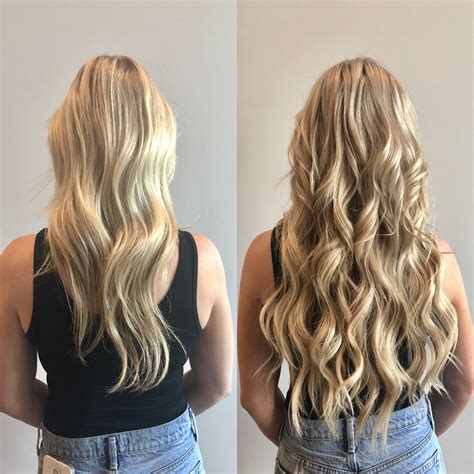Understanding the Benefits of Hair Extensions for Natural Hair
Hair extensions have become a popular method to transform one’s appearance, volumize fine hair, and create length and fullness. For those with natural hair, hair extensions offer numerous benefits:

- Enhance volume: Extensions add instant volume to thin or fine hair, creating a fuller, more luscious look.
- Lengthening locks: Extensions enable you to achieve longer hair without waiting years for your natural hair to grow.
- Adding color: Extensions can add subtle highlights, lowlights, or vibrant pops of color to your hair, creating a dimensional look.
- Protective styling: Extensions can act as a protective layer over natural hair, shielding it from heat damage, chemical treatments, and environmental factors.
- Confidence boost: Longer, fuller hair can enhance your confidence and self-esteem.
Types of Hair Extensions for Natural Hair
Choosing the right type of hair extensions for your natural hair is crucial to achieving a seamless blend. The primary types include:
- Clip-in extensions: Attached with clips, these extensions are easily installed and removed, making them ideal for temporary use or special occasions.
- Tape-in extensions: Applied using double-sided tape, these extensions provide a more secure hold than clip-ins and can last for several weeks.
- Fusion extensions: Attached using heat, these extensions are semi-permanent and create a more natural appearance.
- Sew-in extensions: Sewn into natural hair, these extensions are the most permanent option and require professional installation and removal.
How to Install Hair Extensions on Natural Hair
Installing hair extensions involves a delicate process that should be performed by a professional hairstylist. Here are the general steps for installing fusion extensions:
- Section natural hair: Divide natural hair into small sections using clips to isolate the area where the extension will be attached.
- Apply keratin bond: A keratin bond is attached to the tip of a natural hair strand.
- Apply fusion extension: The extension strand is inserted into the keratin bond and heated using a fusion tool to seal the bond.
- Cool fusion bond: Allow the bond to cool and harden.
- Repeat: Continue the process until the desired volume and length are achieved.
Tips and Tricks for Seamless Blending
To ensure a natural-looking blend between your natural hair and hair extensions, follow these tips:
- Match hair texture: Choose extensions that closely match the texture of your natural hair to avoid an unnatural appearance.
- Avoid weight imbalances: Distribute the weight of extensions evenly across your hair to prevent pulling or damage.
- Style as a whole: Blend the extensions into your natural hair by styling them together using heat tools or styling products.
- Consider a custom cut: Have a hairstylist cut and style the extensions to customize them to your face shape and desired look.
Hair Extensions & Daily Care
Proper care is essential to maintain the health of both your natural hair and hair extensions.
- Wash: Use sulfate-free shampoo and conditioner designed for both natural and extension hair.
- Detangle: Gently brush extensions from root to tip using a wide-tooth comb or brush designed for extensions.
- Avoid heat damage: Limit the use of heat styling tools on both natural hair and extensions.
- Protect from chlorine: Wear a swim cap when swimming to prevent chlorine damage to extensions.
The Importance of Professional Installation
While DIY hair extension installations may seem tempting, it is crucial to seek professional help to ensure proper installation and avoid damage to your natural hair. Trained hairstylists have the skills and experience to:
- Assess hair health: Determine if your hair is strong enough to withstand extensions.
- Choose the right type: Select the most suitable type of extensions for your natural hair and lifestyle.
- Install extensions: Professionally install extensions to ensure a secure hold and prevent damage.
- Provide aftercare guidance: Instruct you on proper care and maintenance techniques.
Frequently Asked Questions
Q1. What is the difference between remy and non-remy hair extensions?
A1. Remy hair extensions retain the hair’s cuticles in the same direction, resulting in smoother, less tangling hair. Non-remy hair has mixed hair cuticles, which can lead to tangling and matting.
Q2. How long do hair extensions last?
A2. The lifespan of hair extensions varies depending on the type. Clip-ins can last for several uses, while tape-ins can last for 4-8 weeks. Fusion and sew-in extensions are semi-permanent and can last for several months with proper care.
Q3. Can hair extensions damage my natural hair?
A3. Damage can occur if extensions are installed improperly or if they are worn for an excessive period without proper care. Regular maintenance and professional removal can minimize the risk of damage.
Q4. What is the ideal weight for hair extensions?
A4. As a general rule, 170-200 grams is suitable for fine hair, 200-230 grams for medium hair, and 230-260 grams for thick hair.
Q5. How often should I wash my hair with hair extensions?
A5. Wash your hair every 2-3 days to prevent buildup and maintain the health of both your natural hair and extensions.
Q6. Can I style my hair with extensions?
A6. Yes, you can style your hair with extensions using heat tools or styling products. However, use caution to avoid excessive heat damage.
Conclusion
Hair extensions can transform your natural hair, enhancing volume, length, and color while boosting your confidence. By choosing the right type of extensions, ensuring professional installation, and following proper care instructions, you can achieve a seamless blend and enjoy the benefits of hair extensions for years to come.
